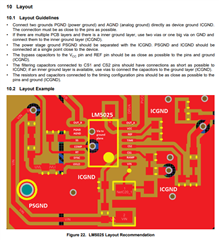the datasheet of LM5025 says to connect AGND and PGND as close as possible to the LM5025 pins.
PGND seems to be used only for the gate driver.
So if i use a current sense resistor between the (OutA) FET-S and Power-GND, why is PGND not connected directly to the FET?
CS1 and CS2 are only 0.25V relative to AGND. So should the connection between AGND and Power-GND be near the current sense resistor?
Also what is the maximum allowed voltage difference between AGND and PGND?


